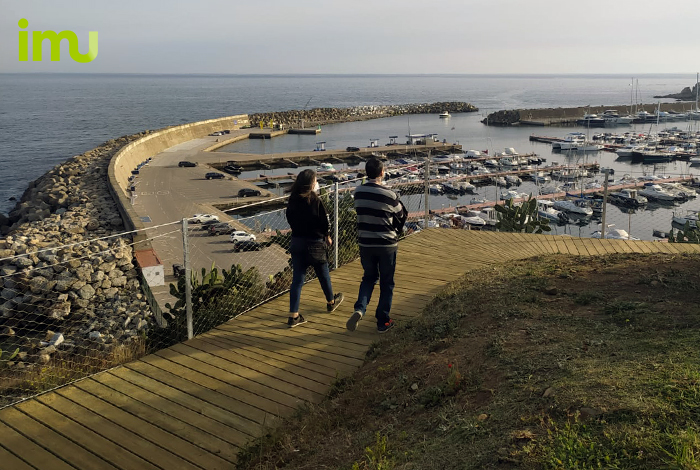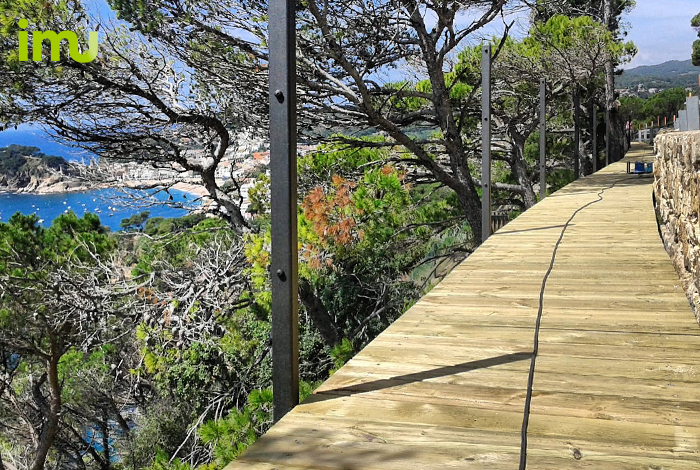The fact is that, over time, some trails become blurred, hard to find or dangerous and thus lose the attention of hikers. Mountain paths cut along the slope become narrow due to the mountain erosion; old pedestrian roads now run alongside busy roads and others disappear with the construction of new infrastructures. At the same time, rural areas are found in the need of creating routes to attract or complement rural tourism and that is often difficult when there’s a lack of space or access to some areas of interest.
The recovery and creation of trails in natural environments was the starting point of iMuntanya in 2003. In these almost twenty years collaborating with our clients to meet their needs while working with the limitations of the terrain, we have developed a product for the recovery of trails or for creating new ones: walkways anchored to the ground. With deep anchoring systems when the surface support is not possible, and with lightened steel structures that allow us to construct in small or difficult to access spaces, the walkways offer many possibilities and different platform and rail finishes.
At the beginning of 2022 we finished the recovery of an old path in Rodes, on the north-east of Spain, with the installation of a walkway anchored to the rock that has also allowed the recovery of livestock passage. Due to the proximity to the nesting of a pair of woodpeckers, this project had to be carried on mostly by hand, avoiding as much as possible the use of machinery and its noise. All materials were manually transported for more than 500m with a 50m elevation gain.
This path had suffered a significant loss of width when the old supporting stone walls failed. The study of our technicians together with ICGC de Tremp detected the need of rock scaling first and confirmed the impossibility of rebuilding the walls due to the steep slope.
This work was an iniciative by PN de l’Alt Pirineu .
Also nested in the Pyrenees mountains, this anchored walkway was an initiative to renovate the Camin Reiau by extending the cycle path of the Garonne River. Not only does that, but it also establishes a safe and adapted path for hikers, avoiding the visitors going inside the forests and offering a tourist boost to one of the most unknown areas of the Vall d’Aran.

In Platja d’Aro, the walkway recovers sections of the popular “Camí de Ronda” around the coastal cliffs and offers magnificent views (2018)
In the coastal towns of Platja d’Aro and Tossa de Mar, two anchored walkways built in 2018 made it possible to recover sections of the famous coastal walk. In the case of Platja d’Aro, the path had suffered a remarkable erosion in a cliff area and it had to be closed to the visitors for safety. This obliged making a long detour in order to continue the walk by the sea and also to miss magnificent views of the coast.
With the support of Helitrans Pyrinées , we brought all the materials and equipment to the action area by heliport .
In Tossa de Mar, the increase of hikers on the “Camí de Ronda” had made the traditional route of the coastal walk increasingly dangerous as it run along with the road. The passage of vehicles with pedestrians endangered the safety of the latter. With the effort and determination of the municipal technicians of the Tossa de Mar City Council and our technical team we resolved satisfactorily the implementation of a structure supported on an old masonry wall that also contained the road embankment. This solution was approved by technicians from the Generalitat’s Territory Department.
Right now, both footpaths offer safety for their users and spectacular views of the coast.
Other projects offer new opportunities for expanded routes. The Palamós anchored walkway creates an alternative route to the “Camí de Ronda”, which also coincided with a busy road, and at the same time allows the City Council to continue the existing urban walk connecting the latter to a much more naturalized space. This new route branch connects the urban area with the beach of El Castell and other coves and cliffs that were not easily accesible beforehand. The walkway offers a promenade with rest areas and panoramic views of the seaport, while allowing the passage of pedestrians in a limited way to natural areas of high ecological value, both fauna and flora, in this part of the coast that suffers from high anthropogenic pressure.

In Palamós, an alternative route to the Camí de Ronda connects the urban area with the Castell beach and other inlets (2021)
The stretches of anchored footpath in Soria’s Duero river also offer a unique experience. The success of the first path, both in the technical resolution and the good reception by inhabitants and visitors, led the City Council to request the creation of a second one. The works, carried out jointly with TRAGSA for the CH del Duero , offer the opportunity to enjoy the landscape without damaging it and from a privileged point of view on this section of the river.
The first pathway becomes a promenade on the right bank of the river Duero, allowing circular routes and the connection of Soria with the town of Garray.
The second one takes the river promenade to the upper part of the city and to the ruins of the old Soria’s Castle where a National Viewpoint is located, as well as other municipal infrastructures. This type of anchored walkway, designed by us, allowed us to overcome the challenge of removing pedestrians using the road by adapting the route and creating a safer path in the middle of the slope.

The two sections of anchored footbridge in Soria offers the visitors a walk along the Duero River and connects with the city by safe paths (2011 and 2014)












